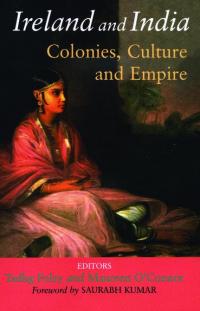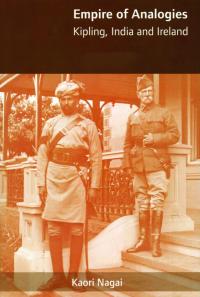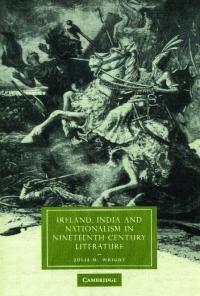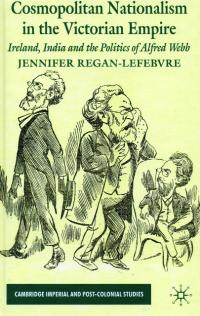Bookworm
Published in
Book Reviews,
Issue 4 (July/August 2010),
Reviews,
Volume 18
 Over the years some rigorous, if isolated, comparative studies on Ireland and India have been published. S.B. Cook’s Imperial affinities and Margaret Kelleher’s The feminisation of famine stand out. The last five years, however, have produced a flowering of scholarship examining Irish–Indian connections. Some of the stimulus came from the Fourth NUI Galway Conference on Colonialism, convened in June 2004 and dedicated to the memory of Edward Said. This gathered together a group of interdisciplinary scholars who were eager to argue over the shared colonial inheritance and national experiences of the two sovereign states. The occasion highlighted deep transnational links. Over the next six years the cross-fertilisation of Irish studies, post-colonial and subaltern approaches and literary history ripened into a rich, hybrid crop of monographs. Here is the pick of the bunch.
Over the years some rigorous, if isolated, comparative studies on Ireland and India have been published. S.B. Cook’s Imperial affinities and Margaret Kelleher’s The feminisation of famine stand out. The last five years, however, have produced a flowering of scholarship examining Irish–Indian connections. Some of the stimulus came from the Fourth NUI Galway Conference on Colonialism, convened in June 2004 and dedicated to the memory of Edward Said. This gathered together a group of interdisciplinary scholars who were eager to argue over the shared colonial inheritance and national experiences of the two sovereign states. The occasion highlighted deep transnational links. Over the next six years the cross-fertilisation of Irish studies, post-colonial and subaltern approaches and literary history ripened into a rich, hybrid crop of monographs. Here is the pick of the bunch.
The proceedings from the Galway conference were edited by Tadhg Foley and Maureen O’Connor and published as Ireland and India: colonies, culture and empire (Irish Academic Press, 306pp, €32.50, ISBN 9780716528388). The highlights include Caoilfhionn Ní Bheacháin’s insight into anti-imperial solidarity in the Irish Free State. The analyses of some Irish individuals who served in different imperial capacities, such as the distinguished Indian civil servant Anthony MacDonnell and the missionary Thomas Gavan Duffy, help to reveal the complexity of Ireland’s relationship to the subcontinent. Owing to the shared experience of famine and the national links built by the Home Rule movements, the nineteenth century looms large.
Julia Wright in Ireland, India and nationalism in nineteenth century literature (Cambridge University Press, 268pp, £22, ISBN 9780521114592) enters the literary contact zone to consider how Irish writers wrote about their own semi-colonial state through the prism of India and how in turn British writers thought about India and Ireland. Early chapters analyse the shared sensibilities of colonial subjection, which led on to the ethical foundation for sovereign independence, driven by the enduring aspiration for universal social justice. Wright’s final chapter on Rudyard Kipling’s Kim is dealt with at length in Kaori Nagai’s Empire of analogies: Kipling, India and Ireland (Cork University Press, 185pp, €39, ISBN 9781859184080). Nagai ponders how Indo–Irish analogies and comparisons became especially important in representing imperial integrity. The connection was on one side about imperial power embodied in the administrations of two viceroys from the Anglo-Irish ascendancy class: Lord Mayo (1868–72), assassinated in the Andaman Islands, and the marquess of Dufferin (1884–8). Conversely, Ireland produced a succession of moderate and extreme nationalists and anti-imperialists who fought India’s corner through Irish eyes, most notably Frank Hugh O’Donnell, Annie Besant and Michael Davitt.

In her study, Cosmopolitan nationalism in the Victorian empire: Ireland, India and the politics of Alfred Webb (Palgrave, 229pp, £52, ISBN 9780230220850), Jennifer Regan-Lefebvre retrieves the inspiring life of the Quaker activist and Irish Parliamentary Party politician Alfred Webb (1834–1908). Webb’s support for reform in India led to his election as president of the Indian National Congress in 1894. This critical biography adds to the broader understanding of the global reach of Irish nationalist thinking in the pre-1916 period, and somewhat exposes the weakness in the persisting view that seeks to downplay or deny the international links underscoring the Irish revolution.
Michael Silvestri’s Ireland and India: nationalism, empire and memory (Palgrave, 328pp, £55, ISBN 9780230216747) complements this previous work with a series of thematic chapters analysing historic linkages. These include Indo–Irish contacts in North America and the transnational influence of Sinn Féin. The politics of memory is well argued through two case-studies: the story of Ulsterman John Nicholson (1822–57), a formidable imperial warrior who was instrumental in the settlement of the Northwest frontier and died in action during the recapture of Delhi in 1857; and the mutiny of the Connaught Rangers, whose actions in the Punjab in 1920 turned them into Irish republican heroes. Silvestri is interested in reading between the black-and-white paradigms produced by stereotypical nationalist and imperialist assessments and demonstrates how temporal and spatial shifts modify historical identities.

In a more theoretical realm, a provocative and stimulating intervention is forthcoming from the post-colonial critic Elleke Boehmer, Empire, the national, and the postcolonial 1890–1920: resistance in interaction (Oxford University Press, 252pp, £26, ISBN 019818445X). Three of the five chapters analyse various Indo–Irish networks of anti-colonial resistance and transnational solidarities, which help reconfigure perception of the imperial margins as crucibles of political and cultural exchange. Mystical, revivalist and political unions between Indian and Irish nationalisms were inflamed by the deep friendship of Margaret Noble (Sister Nivedita) and the yogi and freedom fighter Aurobindo Ghose, while the most famous of the ‘Celtic Orientalist’ literary liaisons between W.B. Yeats and Rabindranath Tagore allows for a re-reading of the relationship between modernism and the imperial fringe.
In Ireland, India and Empire: Indo–Irish radical connections, 1919–1964 (Manchester University Press, 216pp, price?, ISBN 9780719077517) Kate O’Malley widens our understanding of both the diplomatic history and continuing radical solidarities with India post-1922. Indian nationalist leaders of the physical force variety, V.J. Patel and Subhas Chandra Bose, both visited Dublin on separate occasions and met with government officials and the leaders of different anti-imperial groups. There were also menacing alliances forged between left-wing Indians and well-known Republican radicals, which kept the secret agencies of the Empire well occupied. The story of the antics of Roddy Connolly (James Connolly’s son) with the Bengal communist M.N. Roy is particularly intriguing. O’Malley’s revelations, gleaned from her reading of the Indian Political Intelligence (IPI) files released in the 1990s under Britain’s short-lived ‘open government’ initiative, contribute to our gradual comprehension of British counter-insurgency methods. The IPI was established in 1909 as part of the reorganisation of the British intelligence services during Winston Churchill’s spell as British home secretary. The agency was authorised to carry out surveillance of anarchist and revolutionary elements in Indian nationalism. What this archive exaggerates is precisely what all these studies collectively suggest: the Indo–Irish world was a hothouse of radicalism, sedition and anti-imperial subversion. HI

 Over the years some rigorous, if isolated, comparative studies on Ireland and India have been published. S.B. Cook’s Imperial affinities and Margaret Kelleher’s The feminisation of famine stand out. The last five years, however, have produced a flowering of scholarship examining Irish–Indian connections. Some of the stimulus came from the Fourth NUI Galway Conference on Colonialism, convened in June 2004 and dedicated to the memory of Edward Said. This gathered together a group of interdisciplinary scholars who were eager to argue over the shared colonial inheritance and national experiences of the two sovereign states. The occasion highlighted deep transnational links. Over the next six years the cross-fertilisation of Irish studies, post-colonial and subaltern approaches and literary history ripened into a rich, hybrid crop of monographs. Here is the pick of the bunch.
Over the years some rigorous, if isolated, comparative studies on Ireland and India have been published. S.B. Cook’s Imperial affinities and Margaret Kelleher’s The feminisation of famine stand out. The last five years, however, have produced a flowering of scholarship examining Irish–Indian connections. Some of the stimulus came from the Fourth NUI Galway Conference on Colonialism, convened in June 2004 and dedicated to the memory of Edward Said. This gathered together a group of interdisciplinary scholars who were eager to argue over the shared colonial inheritance and national experiences of the two sovereign states. The occasion highlighted deep transnational links. Over the next six years the cross-fertilisation of Irish studies, post-colonial and subaltern approaches and literary history ripened into a rich, hybrid crop of monographs. Here is the pick of the bunch. In her study, Cosmopolitan nationalism in the Victorian empire: Ireland, India and the politics of Alfred Webb (Palgrave, 229pp, £52, ISBN 9780230220850), Jennifer Regan-Lefebvre retrieves the inspiring life of the Quaker activist and Irish Parliamentary Party politician Alfred Webb (1834–1908). Webb’s support for reform in India led to his election as president of the Indian National Congress in 1894. This critical biography adds to the broader understanding of the global reach of Irish nationalist thinking in the pre-1916 period, and somewhat exposes the weakness in the persisting view that seeks to downplay or deny the international links underscoring the Irish revolution.
In her study, Cosmopolitan nationalism in the Victorian empire: Ireland, India and the politics of Alfred Webb (Palgrave, 229pp, £52, ISBN 9780230220850), Jennifer Regan-Lefebvre retrieves the inspiring life of the Quaker activist and Irish Parliamentary Party politician Alfred Webb (1834–1908). Webb’s support for reform in India led to his election as president of the Indian National Congress in 1894. This critical biography adds to the broader understanding of the global reach of Irish nationalist thinking in the pre-1916 period, and somewhat exposes the weakness in the persisting view that seeks to downplay or deny the international links underscoring the Irish revolution.
 In a more theoretical realm, a provocative and stimulating intervention is forthcoming from the post-colonial critic Elleke Boehmer, Empire, the national, and the postcolonial 1890–1920: resistance in interaction (Oxford University Press, 252pp, £26, ISBN 019818445X). Three of the five chapters analyse various Indo–Irish networks of anti-colonial resistance and transnational solidarities, which help reconfigure perception of the imperial margins as crucibles of political and cultural exchange. Mystical, revivalist and political unions between Indian and Irish nationalisms were inflamed by the deep friendship of Margaret Noble (Sister Nivedita) and the yogi and freedom fighter Aurobindo Ghose, while the most famous of the ‘Celtic Orientalist’ literary liaisons between W.B. Yeats and Rabindranath Tagore allows for a re-reading of the relationship between modernism and the imperial fringe.
In a more theoretical realm, a provocative and stimulating intervention is forthcoming from the post-colonial critic Elleke Boehmer, Empire, the national, and the postcolonial 1890–1920: resistance in interaction (Oxford University Press, 252pp, £26, ISBN 019818445X). Three of the five chapters analyse various Indo–Irish networks of anti-colonial resistance and transnational solidarities, which help reconfigure perception of the imperial margins as crucibles of political and cultural exchange. Mystical, revivalist and political unions between Indian and Irish nationalisms were inflamed by the deep friendship of Margaret Noble (Sister Nivedita) and the yogi and freedom fighter Aurobindo Ghose, while the most famous of the ‘Celtic Orientalist’ literary liaisons between W.B. Yeats and Rabindranath Tagore allows for a re-reading of the relationship between modernism and the imperial fringe.

















